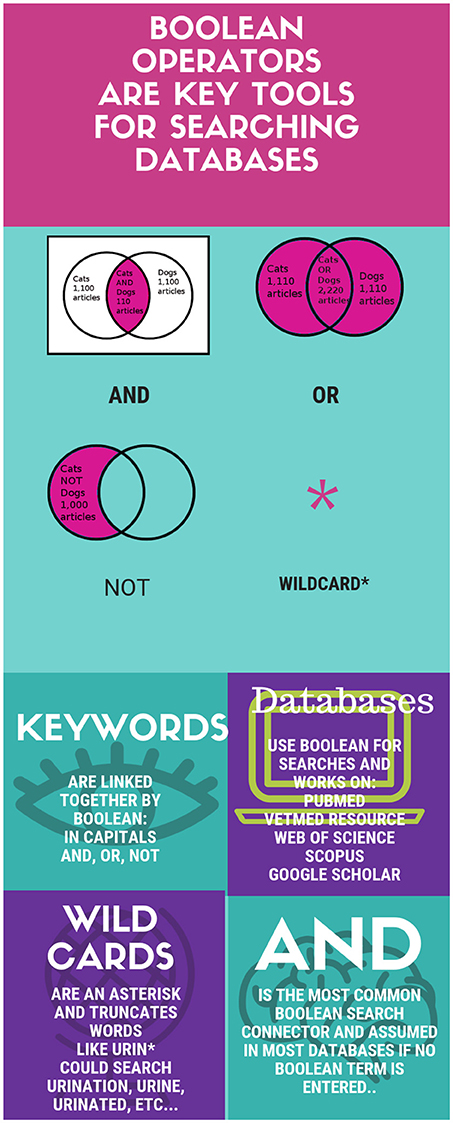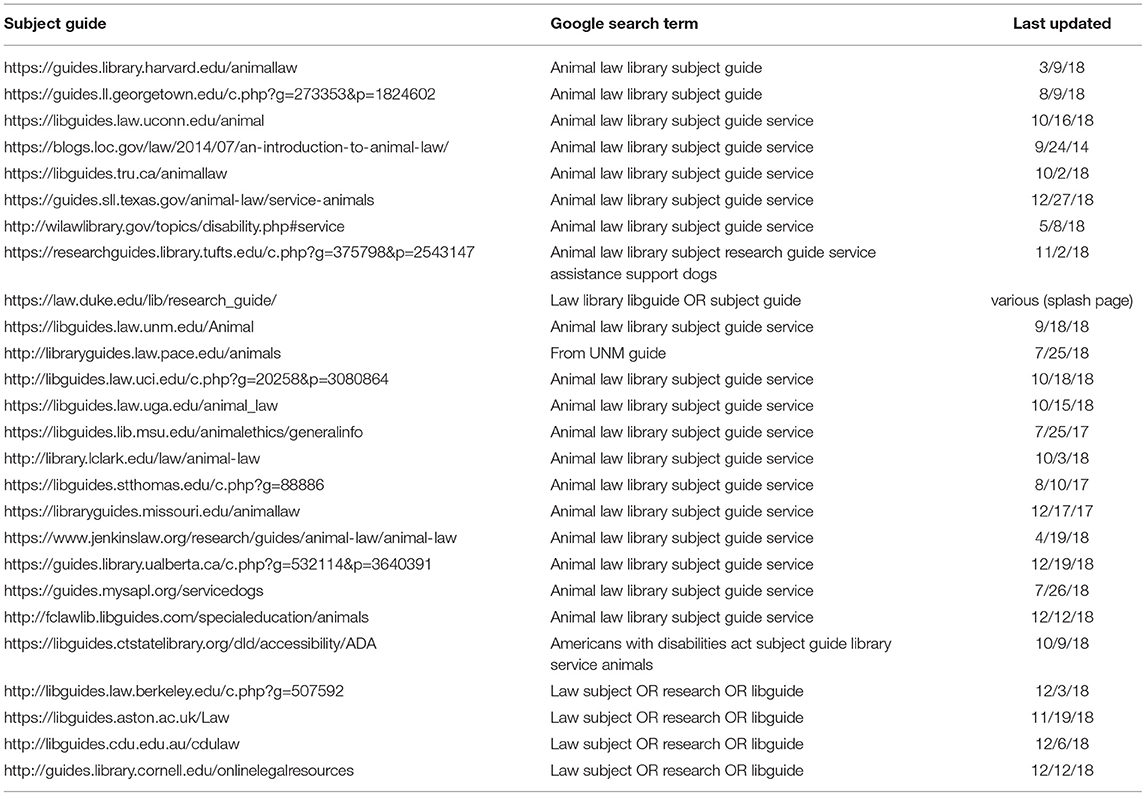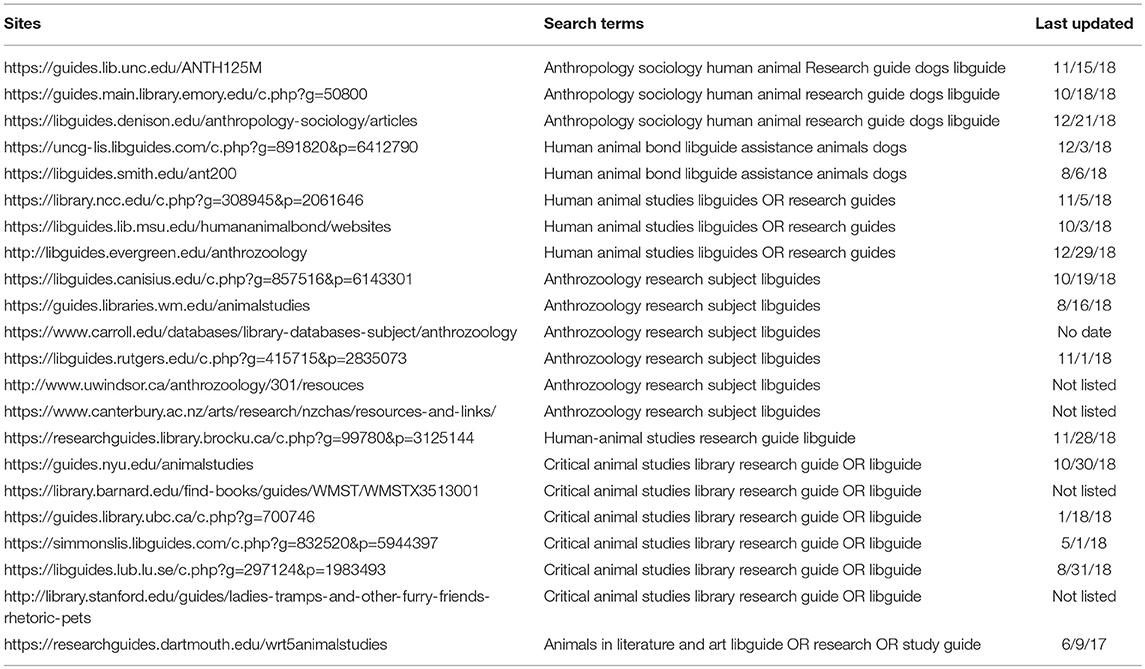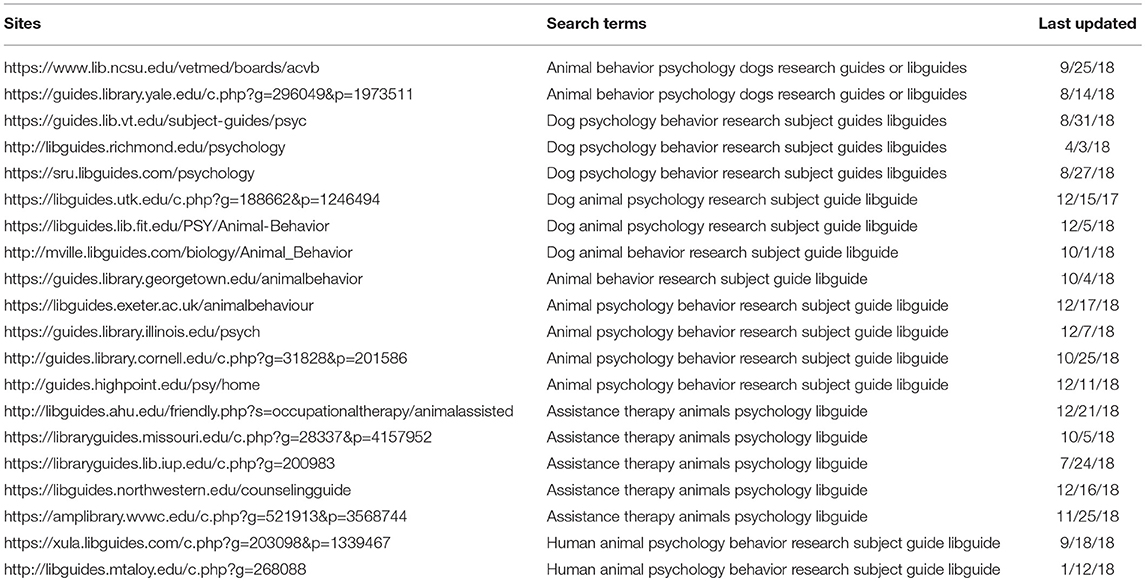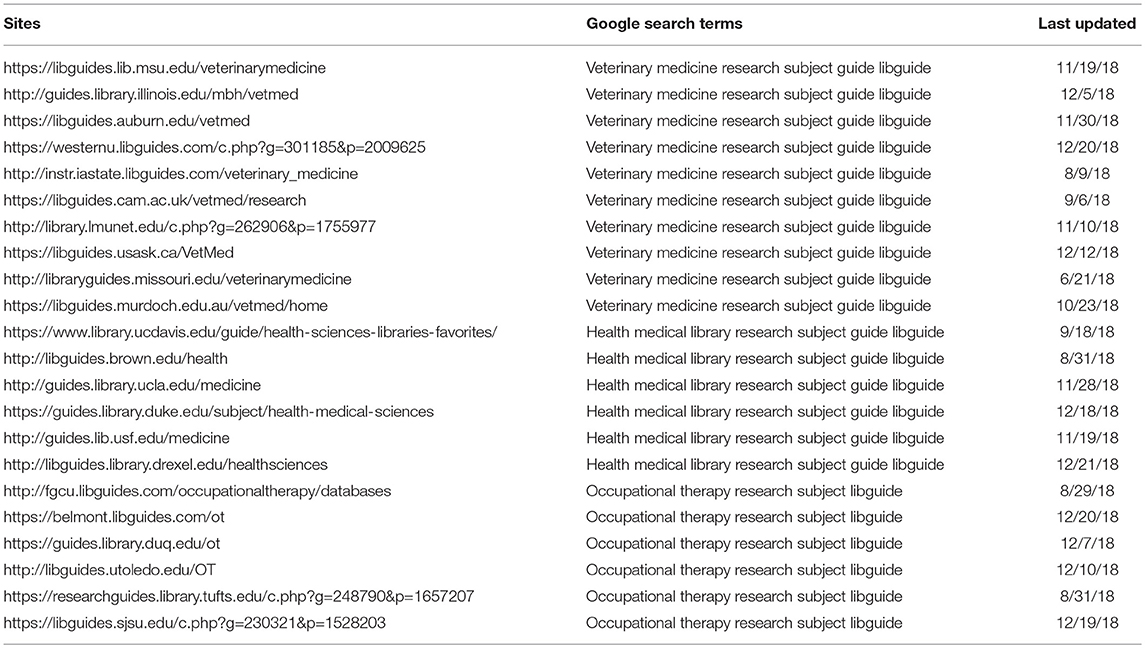- University Library, University of California, Davis, Davis, CA, United States
Successful search strategies are based on good background knowledge and a focused clinical research question. Due to the multidisciplinary nature of research involving assistance animals means there is no one universal database to answer all research questions. The topic of assistance animals can yield better results when creating subheadings based on discipline focus. Subheadings have been divided into ethicolegal, sociocultural, psychobehavioral, and medical/veterinary. Each subheading, or discipline, has their own specific databases that will yield higher relevant content than others. Contacting local academic librarians and utilizing search guides created by those librarians can lead to successful search strategies. The goal of this article is to create a template for successful search strategies in assistance animals. Eighty-nine subject guides curated by academic librarians are reviewed to identify strong databases for each topic of ethicolegal, sociocultural, pscyhobehavioral, and medical/veterinary topics in relationship to assistance animals. A live subject guide has been created and maintained at https://www.library.ucdavis.edu/guide/assistance-animals/
Introduction
Assistance dogs touch on all levels of academic thinking that cannot be researched with one database or search strategy. Like the Medical Subject Headings utilized by National Library of Medicine, many diverse subheadings can be incorporated into this subject to improve the sensitivity (or finding the highest amount of relevant articles in searches) (1). The study of assistance animals is highly interdisciplinary in nature because of the level of human and non-human involvement. Four major subheadings (or broader disciplines) have been identified in relationship to assistance animals: ethicolegal, sociocultural, psychobehavioral, and medical/veterinary. All of these disciplines may overlap to some degree, but this broader grouping of disciplines as subheadings can help the researcher identify ideal databases based on the penchant of their research. The goal of this paper is not to create a strict bibliography but to identify key search strategies and tools to find relevant information regarding any level of research around Assistance Animals. Whenever possible, utilizing specialized academic libraries and librarians will prove to be extremely beneficial.
Barriers to Searching on Assistance Dogs
In models of evidence-based veterinary medicine training, it is important to develop a strong clinical question or have a developed topic. The same applies to any research. Before having a developed, or “foreground” question, it may require searching “background” information. The sources that are utilized to answer more generalized background questions will be different from someone who is well-versed in a topic and has a highly developed research question (2, 3).
Information overload can be a concern for any investigator, particularly when using search engines like Google or Google Scholar (4). A vague question will yield too many and irrelevant results, so it is important to develop a two-step strategy: A generalized inquiry to further familiarize oneself with the topic and develop a good research question which will lead to a more focused search that will yield higher relevant scholarly literature with fewer irrelevant results (2, 3).
While web search engines like Google Scholar are becoming more efficient at retrieving similar data to bibliographic databases, they still don't have the sensitivity of the more costly bibliographic databases (4–6). Freely accessible databases and search engines will be addressed for each subheading, but it is important to keep in mind that many universities (particularly land grant public universities) may allow the public to enter their library and access their resources (including the librarians) from the physical library. Additionally, many public libraries (89% of 29 scanned library homepages across the United States) can offer generalized bibliographic databases accessible from the comfort of home (7). Inter-Library Loans are also services offered by public libraries to give non-academic affiliated persons access to academic resources (8).
Encouragingly, as more journals are on an Open Access (OA) model which allows for a reader to freely access their content, more researchers have been able to find relevant literature. It is also important to keep in mind that many journals utilize a hybrid Open Access model, where some articles may be accessible while others are behind a subscription pay wall. Hybrid models have created some degree of challenge in the discovery of open access articles because they are embedded in subscription journals (9, 10).
Generalized Search Strategies for Undeveloped Research Topics and Background Information
Asking a good clinical question is predicated on familiarity with a topic in general. A few resources can be utilized to answer background questions or get an overview of a topic. Textbooks and quality websites are certainly a good starting point. Textbook retrieval is as simple as using your library catalog and using a few keywords on the topic of interest. Searching google or any other web searching service is also a good starting point but requires judicious evaluation and selection.
An axiom of the web is that it can have quality and lackluster content in the same results. A few tools have been developed to improve the evaluation of websites. One technique is utilizing a checklist to see how the site measures up to some basic evaluative components (11, 12). Another method that may not be mutually exclusive to the checklist, is to compare websites and see if information on the website is corroborated from other sources (11–13). CRAAP represents utilizing the following criterion to use in evaluating a website (retrieved 12/20/2018 from http://www.csuchico.edu/lins/handouts/eval_websites.pdf):
• Currency – Is the topic maintained and up to date?
• Relevance – Is this information relevant to the topic you are interested in?
• Authority – Who is the author and are they qualified to write on this topic?
• Accuracy- Where is this information coming from and does it use evidence?
• Purpose – why is this paper being written? Is the author objective?
Arguments have been made that a rigid checklist is too much effort and a student can simply compare websites to identify quality differences between them and find what data is corroborated across sources (13). A caveat is that corroboration does require identification that the information came from two independent sources and not from the same one.
Performing background searches is extremely helpful in developing successful keywords. For instance, looking at an E-book on assistance animals can help identify alternative keywords: guide, hearing, service, social, support, or therapy animals. Similarly, common guide and service breeds of dogs are Labrador Retrievers, Golden Retrievers, and German Shepherds which can also help in finding search terms (14). A thesaurus (whether subject or general) can also be a useful tool for finding good keywords for searches (15).
Understanding the Language of Searching: Boolean
Databases and search engines use similar language in combing the web or database, and this language is Boolean logic. Boolean simply takes terms, or keywords, and either looks for the appearance of them together with “AND” (which is often assumed), or it looks for any instance of any term entered with “OR” (see Figure 1). The general principle is that if a search needs to be narrowed with fewer results, use “AND, and if it needs to be widened with more results, use OR. Many search engines, like Google, use Boolean, but are more limited than many databases. Google assumes “AND,” and will use “OR” if it is written in caps between keywords. “NOT” for exclusion is represented by a—(dash) and Google can limit results by site, words in a title, url, and file type (site:, intitle: or allintitle:, inurl:, or filetype:, respectively) (16, 17). The first rule of any database or web engine being searched, is to contact a librarian or find the help icon on the database that explains what Boolean operators and other tools exist and how they can be used.
Focused Searching (by Subheading)
Once a research question has been formed, it is time to start to focus on discovering answers to that specific question. The list below is a starting point based on many subheadings or disciplines that can be pursued. The best option is to contact a subject specialist librarian at the nearest academic library. Many University libraries are open to the public and this is a good opportunity to use its resources, including and most importantly, the librarian. Subject specialist librarians at most institutions will curate online subject guides that contain the best content tailored to the level of database access at their institution. The best approach to starting the search of a focused research question is to work with a local librarian to develop the search strategy.
Methodology for Subject Searching
A subject guide dedicated to ethicolegal, sociocultural, psychobehavioral, and medical aspects of assistance animals will be curated and maintained at https://www.library.ucdavis.edu/guide/assistance-animals/ Twenty to thirty subject guides pertaining to the following subheadings were consulted: ethicolegal, sociocultural, psychobehavioral, and medical aspects (see Tables 1–4). Search strategies utilized in Google are recorded including authorship (if available) and last date updated when the site was being evaluated. Subject guides utilized were retrieved in order of retrieval on Google search engine results and based on relevance. The number of subject guides utilized was an arbitrary saturation point that the author felt represented a good overview of resources in the subheading area. The total number of subject guides consulted were 89 averaging 22 subject guides per subheading. Subject guides were searched and evaluated between December 21, 2018 and January 2, 2019. In lieu of a specific bibliography, the goal of this article is to identify resources for the investigator to develop their own bibliography at point and time of need. Common repetition of databases between subject guides were used to create these resource lists (see Figures 2A–D). Additionally, Three of the five databases were searched for each subheading to see what results (due to the variability in search functionality of databases, some filters were applied appropriate to the topic) occurred when searching: service AND dogs (see Figures 2A–D). All searches done in databases for Figures 2A–D were performed February 11, 2019.
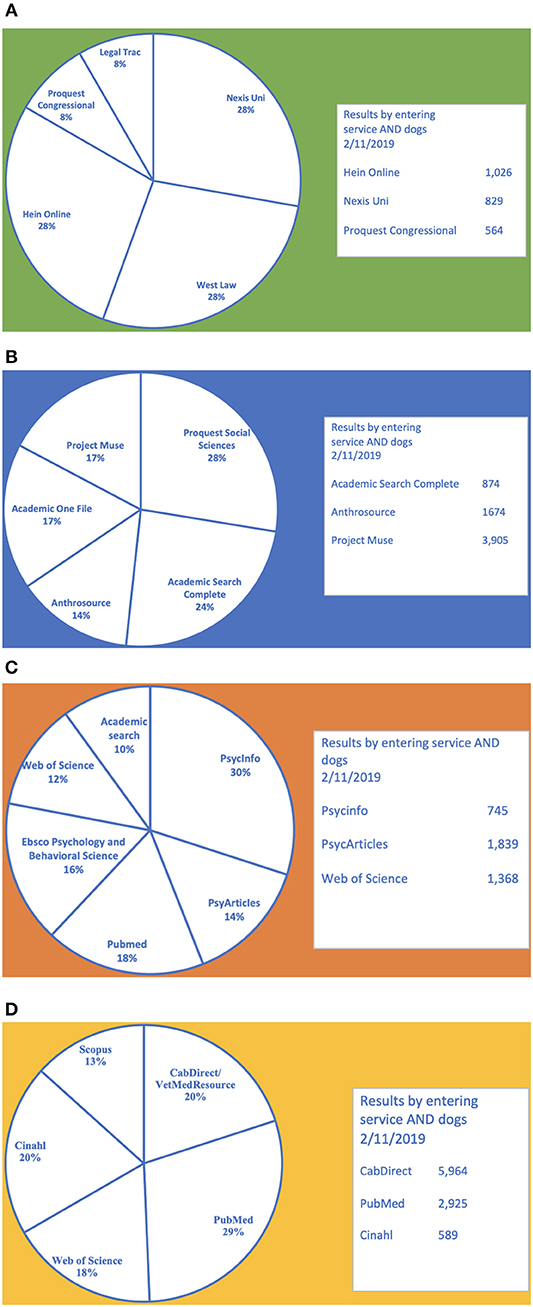
Figure 2. Five most frequently cited databases from 26 Sociocultural subject guides. (B) Five most frequently cited databases from 22 Sociocultural subject guides. (C) Five most frequently cited databases from 20 Psychobehavioral subject guides. (D) Five most frequently cited databases from 21 Medical/veterinary subject guides.
Included in each subheading are journals that are often referenced, but it is worth mentioning that good information comes from many sources, not just one journal (18). The cited journals are only meant to indicate good places to start browsing, but not to conduct an exhaustive search which should be performed with databases. Tools like Google Scholar's H5 score, Clarivate's Web of Science Journal Citation Reports, Scopus' Citescore, Eigenfactor, or Scimago Journal and Country Rank can all help to identify journals that are frequently cited in a particular discipline (19).
Ethicolegal
Ethical and legal issues that surround assistant animals has become a large area of interest in recent years. Legal recognition or definition of different types of assistant animals is important to many investigators (20). Freely accessible resources to explore is Cornell University's Legal Information Institute (LII—https://www.law.cornell.edu) (Personal communication with Adam Siegal on 12/20/2018) and the Library of Congress Law Library (http://www.loc.gov/law/) that provides education and a list of important databases and e-resources. Google Scholar started discovering legal cases in 2009, which makes it a good freely usable tool for legal research. Google Scholar also has a case law filter to help search the legal literature (21). Bepress has an Animal Law Digital Commons that identifies open access (freely available) legal content from many university repositories. Recently purchased by Elsevier, there are some concerns about Bepress' continued open access role (22). Ebsco's GreenFile, and Masterfile are also useful general databases available through many public libraries to help retrieve legal literature (7). Assistance animals are covered under a specialized and rapidly growing area called Animal Law, “Under its broadest definition, animal law covers all aspects of the law—legislative, judicial, regulatory, executive—that deal with issues pertaining to non-human animals”(23). Examining 26 generalized legal research guides and Animal Law specific research guides (see Table 1). The following databases were cited the most: Thomson Reuters' Westlaw, Nexis Uni (formerly LexisNexis), and Hein Online (which has a special collection on Animal Studies: Law, Welfare, and Rights) (see Figure 2A). Additional databases for consideration are Proquest's Congressional and PAIS. Website sources that have stood out as very useful are Michigan State University's Animal Legal and Historical Center, the National Anti-Vivisection Society's Animal Law Resource Center, and governmental sites like Housing and Urban Development and Americans with Disabilities Act. Journals to follow that cover animal law include Animal Law Review, Journal of Animal Law, and the Journal for Critical Animal Studies.
Sociocultural
A large scale multi-disciplinary approach has arisen to understand humans through their interactions with non-humans. This has given rise to the multidisciplinary efforts called anthrozoology, human-animal studies, or animal studies (24). Identifying the role of assistance animals in a larger psychological, societal, biological, humanistic, or cultural context has become increasingly important. Duke University's Evolutionary Anthropology program has developed the Canine Cognition Center that researches service dogs from an evolutionary perspective. Google Scholar poses a particular problem as recent research suggests that a great deal of social science content is still locked in subscription databases (5, 25). Examination of 22 library subject guides on anthrozoology, animal studies, and human-animal studies have yielded a great deal of resources (see Table 2). Besides Google Scholar, freely available resources include Elsevier's Bepress Digital Commons on Animal Studies and the US Department of Agriculture's Agricola database. Besides Agricola, freely available US government sites like science.gov and the Catalog of US Publications are useful resources to investigate. Many public libraries do have access to some premium access databases that have sociocultural content like Ebsco's Academic Search Complete, Gale's Academic One File and Ebsco's Greenfile (7). Premium databases at academic institutions that warrant investigation (see Figure 2B) are Wiley's AnthroSource, Proquest's Social Sciences and PsycInfo databases and JSTOR. Elsevier's Scopus and Clarivate's Web of Science, and Ebsco's Anthropology Plus also warrant consideration. Websites to explore include Animals and Society Institute, International Society for Anthrozoology (ISAZ),and H-Animal. There are many journals that explore the relationship of animals and people, which includes assistant animals. Some frequently cited journals include: Anthrozoos, Humanimalia, Animal Studies Journal, Between the Species, Antennae, and Animals.
Psychobehavioral
A great deal of disciplinary overlap occurs between anthrozoology and psychology. Psychological aspects for consideration are the relationship between the human and assistance animal, the psychological behavior for selection of the assistance animal and their training (26, 27). Examination of 20 library subject guides on general psychology and animal behavior suggests a number of resources to find information (see Table 3). Freely available databases and search engines include Google Scholar, Pubmed, and Educational Resources Information Center (ERIC). More academic oriented resources include Proquest's PsycInfo, American Psychological Association's PsycARTICLES, Ebsco's Psychology and Behavioral Sciences Collection, Clarivate's Web of Science, and Ebsco's Academic Search Complete (see Figure 2C). Useful online resources include: Psychology Today, National Institute of Mind Health, Animal Behavior Society, Association for the Study of Animal Behavior, and the American College of Veterinary Behaviorists. Relevant journals to browse include: Applied Animal Behavior Science, Journal of Comparative Psychology, Animal Behavior, Animal Cognition, Journal of Experimental Psychology, and the American Journal of Occupational Therapy.
Medical/Veterinary
In a broad sense, medical considerations can apply to either the assistant animal or whom the assistant animal is assisting. Occupational therapy has found assistant animals as increasingly popular and beneficial assistive tools to the disabled (28, 29). Twenty-two subject guides were examined relating to veterinary medicine and the treatment of assistant animals, general human medicine and occupational therapy in the utilization and benefit of assistant animals in human medicine (see Table 4). A number of freely available databases are utilized in both medicine and veterinary Medicine. NIH's Pubmed (Medline) is one of the best freely available resources. Google Scholar also has a high success rate in retrieving medical and veterinary related content (5). Additional freely available tools include VetSRev (an index of veterinary systematic reviews), ERIC (includes Social Service citations and occupational therapy) and Agricola (which also includes veterinary content). OTSeeker is a freely searchable database that is specifically geared for occupational therapy. Subscription databases that are most cited include CAB Direct or VetMed Resource, Proquest's PsychInfo and Nursing and Allied Health databases. Ebsco's Cinahl, Clarivate's Web of Science, and Elsevier's Scopus have also been frequently identified as important databases across the veterinary, medical, and occupational health research guides (see Figure 2D). Cab Direct has been identified as covering the most veterinary titles and vital to any veterinary search (30). Online resources that have been cited are Cornell Consultant, Best Bets for Vets, British Small Animal Veterinary Association Library, US Food and Drug Administration, Centers for Disease Control, American Occupational Therapy Association and the Veterinary Information Network. Relevant journals to browse include the American Journal of Veterinary Research, the Journal of the American Veterinary Medical Association, Journal of Veterinary Internal Medicine (OA), Veterinary Record, Journal of the American Medical Association, Lancet, New England Journal of Medicine, Nature, Science, and Occupation Therapy International (OA).
Conclusion
Effective searching and research start with identifying available resources to answer the investigator's question. The next step is whether a focused foreground question has been formed, or more background information needs to be retrieved. Background information or questions can be answered with textbooks and quality websites. Foreground or focused questions have to be answered by finding scholarly journals in reliable databases or search engines (i.e., Google Scholar). While freely available, Google Scholar is not equipped to answer all aspects of questions that the investigator may have (5). Taking advantage of the investigators closest academic library and librarian is the best first step. Public libraries are also an important resource for those without academic affiliations. Many public libraries have research databases and interlibrary loan programs with regional academic libraries. Based on the type of foreground question and which disciplines are being incorporated, there are different optimal databases.
The greatest limitation of this article is that there cannot be any prescriptive research guide for everyone. A great deal of factors influence how the research topic is approached. As multidisciplinary approaches, like anthrozoology, become more common place, it requires identifying and searching a larger breadth of unique databases. Additionally, regional and academic levels of access influence the researcher's resources and strategies. The primary goal of this article is to identify that all researchers of all levels have a number of resources at their disposal, and it starts by identifying what academic and in some cases, public libraries and librarians, are at the researcher's disposal. Additionally, very few academic libraries don't have subject guides to assist the researcher in identifying the best resources for their institution and should be utilized. Please see Supplementary Figure S1 for links of online content referred to in this article.
Author Contributions
The author confirms being the sole contributor of this work and has approved it for publication.
Conflict of Interest Statement
The author declares that the research was conducted in the absence of any commercial or financial relationships that could be construed as a potential conflict of interest.
The reviewer MW declared a past shared affiliation, with no collaboration, with the author to the handling editor at time of review.
Supplementary Material
The Supplementary Material for this article can be found online at: https://www.frontiersin.org/articles/10.3389/fvets.2019.00063/full#supplementary-material
References
1. Golder S, McIntosh HM, Duffy S, Glanville J. Developing efficient search strategies to identify reports of adverse effects in medline and embase. Health Inform Libr J. (2006) 23:3–12. doi: 10.1111/j.1471-1842.2006.00634.x
2. Robertson SR. Refining the clinical question: the first step in evidence-based veterinary medicine. Vet Clin North Am Small Anim Pract. (2007) 37:419–31. doi: 10.1016/j.cvsm.2007.01.002
3. Dalal HA, Kimura AK, Hofmann MA. Searching in the wild: observing information-seeking behavior in a discovery tool. In: Proceedings of the ACRL. Portland, OR (2015). p. 668–75.
4. Bates J, Best P, McQuilkin J, Taylor B. Will web search engines replace bibliographic databases in the systematic identification of research? J Acad Libr. (2017) 43:8–17. doi: 10.1016/j.acalib.2016.11.003
5. Stirbu S, Thirion P, Schmitz S, Haesbroeck G, Greco N. The utility of google scholar when searching geographical literature: comparison with three commercial bibliographic databases. The J Acad Libr. (2015) 41:322–9. doi: 10.1016/j.acalib.2015.02.013
6. Hughes E. Web search engines - Not yet a reliable replacement for bibliographic databases. J Acad Libr. (2018) 13:85–7. doi: 10.18438/eblip29378
7. Fausak E. Utilization of freely available resources to find and access the evidence. In: 6th EBVMA Symp. (EBVMA). Available at: https://ebvma.org/utilization-of-freely-available-resources-to-find-and-access-the-evidence/
8. Little M, Leon L. Assessing the value of ILL to our users: a comparative study of three US libraries. Interlend. Docum Supply. (2015) 43:34–40. doi: 10.1108/ILDS-10-2014-0051
9. Kingsley DA. Paying for publication: issues and challenges for research support services. Australian Acad Res Libr. (2014) 45:262–81. doi: 10.1080/00048623.2014.945135
10. Mikki S. Scholarly publications beyond pay-walls: increased citation advantage for open publishing. Scientometrics. (2017) 113:1529–38. doi: 10.1007/s11192-017-2554-0
11. Lewis AB. What does bad information look like? Using the CRAAP test for evaluating substandard resources. Issues Sci Technol Libr. (2018) 2018:1–5. doi: 10.5062/F41N7ZC4
12. Metzger MJ. Making sense of credibility on the Web: models for evaluating online information and recommendations for future research. J Am Soc Inform Sci Technol. (2007) 58:2078–91. doi: 10.1002/asi.20672
13. Meola M. Chucking the checklist: a contextual approach to teaching undergraduates web-site evaluation. Portal. (2004) 4:331–344. doi: 10.1353/pla.2004.0055
14. Adams KM. A Brief Information Resource on Assistance Animals for the Disabled. Beltsville, MD: US Deptof Agriculture, Agricultural Research Service, National Agricultural Library, Animal Welfare Information Center (2004). Available online at: http://purl.access.gpo.gov/GPO/LPS80860 (Accessed December 20, 2018).
15. Bramer WM, Jonge GB de, Rethlefsen ML, Mast F, Kleijnen J. A systematic approach to searching: an efficient and complete method to develop literature searches. J Med Libr Assoc. (2018) 106:531–41. doi: 10.5195/jmla.2018.283
17. Refine Web Searches - Google Search Help. Available online at: https://support.google.com/websearch/answer/2466433 (Accessed December 30, 2018)
18. Williams HC. Evidence-based veterinary dermatology - better to light a candle than curse the darkness. Vet Dermatol. (2010) 21:1–3. doi: 10.1111/j.1365-3164.2009.00873.x
19. Walters WH. information sources and indicators for the assessment of journal reputation and impact. Reference Libr. (2016) 57:13–22. doi: 10.1080/02763877.2015.1088426
20. AVMA Public Policy/Animal Welfare Devision. Assistance Animals: Rights of Access and the Problem of Fraud. (2017) Available online at: https://www.avma.org/KB/Resources/Reports/Documents/Assistance-Animals-Rights-Access-Fraud-AVMA.pdf (Accessed December 30, 2018).
22. Ferguson CL. Elsevier, bepress, and a glimpse at the future of scholarly communication. Ser Rev. (2018) 44:51–6. doi: 10.1080/00987913.2018.1434379
24. Hurn S. What's in a name? : anthrozoology, human-animal studies, animal studies or…? Anthropol Today. (2010) 26:27–8. doi: 10.1111/j.1467-8322.2010.00739.x
25. Rowan AN. The origins and first ten years of Anthrozoös. Anthrozoös. (2012) 25:s5–7. doi: 10.2752/175303712X13353430376896
26. Weiss E, Greenberg G. Service dog selection tests: effectiveness for dogs from animal shelters. Appl Anim Behav Sci. (1997) 53:297–308. doi: 10.1016/S0168-1591(96)01176-8
27. Wilsson E, Sundgren P. The use of a behaviour test for the selection of dogs for service and breeding, I: method of testing and evaluating test results in the adult dog, demands on different kinds of service dogs, sex and breed differences. Appl Anim Behav Sci. (1997) 53:279–95. doi: 10.1016/S0168-1591(96)01174-4
28. Camp MM. The use of service dogs as an adaptive strategy: a qualitative study. Am J Occup Ther. (2001) 55:509–17. doi: 10.5014/ajot.55.5.509
29. Herlache-Pretzer E, Winkle MY, Csatari R, Kolanowski A, Londry A, Dawson R. The impact of service dogs on engagement in occupation among females with mobility impairments: a qualitative descriptive study. Int J Environ Res Public Health. (2017) 14:649. doi: 10.3390/ijerph14060649
Keywords: assistant animal, service animals, therapy animals, assistive tools, disabilities, databases, subject guides, service dogs
Citation: Fausak ED (2019) Effective Multidisciplinary Search Strategies for Assistance Animals: A Librarian's Perspective. Front. Vet. Sci. 6:63. doi: 10.3389/fvets.2019.00063
Received: 03 January 2019; Accepted: 13 February 2019;
Published: 19 March 2019.
Edited by:
Mariko Yamamoto, Teikyo University of Science, JapanReviewed by:
Andre Joseph Nault, University of Minnesota Twin Cities, United StatesMary W. Wood, University of California, Davis, United States
Copyright © 2019 Fausak. This is an open-access article distributed under the terms of the Creative Commons Attribution License (CC BY). The use, distribution or reproduction in other forums is permitted, provided the original author(s) and the copyright owner(s) are credited and that the original publication in this journal is cited, in accordance with accepted academic practice. No use, distribution or reproduction is permitted which does not comply with these terms.
*Correspondence: Erik Davis Fausak, ZWRmYXVzYWtAdWNkYXZpcy5lZHU=
 Erik Davis Fausak
Erik Davis Fausak